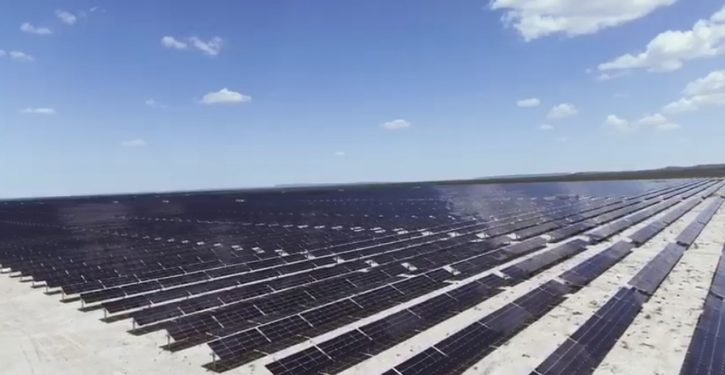
In September of 2018, then President Trump addressed the United Nations General Assembly. Among other messages, he told Germany that it needed to alter its energy policy if it didn’t want to become too dependent on Russia for its natural gas. The German delegation openly snickered at such transparent nonsense.
They aren’t laughing now. Trump, though overstating his case (of course he did), was spot-on as the Russian invasion of Ukraine, the West’s sanctions and Russia’s reduction in exports have made abundantly clear. Germany and most of Western Europe are now scrambling to bring their policies into line with energy supplies before the onset of winter. They’ve suddenly discovered that natural gas and nuclear generation aren’t such bad things after all, that other countries than Russia can supply the energy that’s needed to maintain a healthy standard of living and that wind and solar can’t get close to doing that job.
In short, “facts on the ground” have laid bare what many observers have long known – that transitioning from fossil fuels to wind and solar is at best a herculean task in the long run and impossible in the short. In that way at least, Russia has taught us a valuable lesson. Electric power generated entirely by wind and solar is a pipe dream.
This article by Mark Mills is very long and a gold mine of information on just why fossil fuels will make up a major part of our energy supply for long into the future. In a nutshell, fossil fuels provide far more energy far more cheaply than any alternative. That’s why, after about $5 trillion of worldwide spending on renewables, wind and solar still only provide about 5% of global electricity supply. Storing oil, gas and coal for future use in electric generation is easy and cheap, while storing electricity itself (batteries) costs about 30 times more.
Plus, demand for electric power is rising and will continue to do so for many decades. The global demand for automobiles, refrigeration, heating and air-conditioning, etc. can only increase as nations like China and India become more affluent. And climate activists’ demand for more electric vehicles will increase demand for electric power by as much as 25%.
Since wind and solar require batteries to store the energy they produce only off and on, what are the facts about battery production? Mills goes into detail.
[A]t today’s and likely future prices, building enough batteries to store 12 hours of electricity for the U.S. would cost about $1.5 trillion, and that scale of storage would still leave the nation regularly third-world dark.
Generation by natural gas would be a tiny fraction of that cost and would, unlike that provided by wind and solar, be reliable. Meanwhile, EVs take far longer to refuel than do conventional vehicles which requires recharging stations to be far larger than gasoline stations with far more “pumps” and expensive supercharging technology.
The combination of these factors translates into 10 to 20 times the costs of the fueling infrastructure to provide the same functional utility.
But cost is just one part of the problem presented by batteries.
As a seminal IEA analysis observed, an energy transition is a “shift from a fuel-intensive to a material-intensive energy system.”[46] That agency’s estimates for a path that is far short of completely eliminating hydrocarbons show the need to increase the supply of minerals such as lithium, graphite, nickel, and rare earths by 4,200%, 2,500%, 1,900%, and 700%, respectively, by 2040…
A recent World Bank report observed, in an epic understatement, that “ambitious climate action will bring significant demand for minerals.”…
Fully replacing hydrocarbons using SWB [solar/wind/battery] technologies would require a quantity of minerals that exceeds the known global reserves of those minerals…
Even if it were feasible, there are still no plans to meet the scale of mineral demands in the time frames contemplated. This means, in short, that regardless of price, policies, and mandates, the world won’t be able to build the machines to meet transition aspirations.
And where would all those minerals come from? Not the U.S. No, we’d need to import them from countries not notoriously friendly to us. Transitioning to wind and solar would mean placing our entire energy future beyond our control. Not sound policy.
Start with the facts that the U.S. today is dependent on imports for 100% of some 17 minerals that are already listed as critical for national and economic security and that, for 28 other critical minerals, U.S. imports account for more than half of existing domestic demand…
China’s global market share in refined energy minerals is double the market share that the Organization of the Petroleum Exporting Countries (OPEC) has in oil markets. China is the world’s top producer (40% market share) of aluminum, a metal that belongs on but is usually absent from the list of energy transition minerals. Then there’s the fabrication of polysilicon, the key raw material for solar panels; China has about an 80% market share of all polysilicon supply…
Russia produces 6%[57] of the world’s aluminum (four times the U.S. output)[58] and 10% of global nickel (number three in the world) and is one of the top copper producers at about 4% of world supply (roughly equal to that of the U.S.). Chile, the largest copper producer with a 20% market share, has a new socialist president who has promised social justice and environmental reforms in mining.[59] The number two and three producers of copper are Peru and the Congo. The top nickel producer is Indonesia, not generally viewed as having a stable political environment.
Meanwhile, the U.S. is dependent on precisely no one for oil, gas and coal.
And, if we were to significantly transition to wind and solar, increased demand would mean prices would soar. Some already are.
Today, the energy sector uses less than 15% of the various critical minerals that are also used for other purposes. But if transition goals were achieved, that share rises from 40% to 70% (at least). Just the pursuit of such an increase and shift in commodities usage would lead to higher and more volatile prices. Even in these early days of potential radical increases in demand, lithium prices are already up nearly 1,000% over the past two years…
[M]any forecasts now see rising battery prices.[60] Morgan Stanley expects that EV makers will need to raise prices by 25% because of the lithium price explosion alone.[61] (Vehicle price increases have already been announced by Tesla and BYD, the world’s two biggest EV makers.)
It’s much the same for wind turbines and solar panels for which materials already account for about 70% of the cost of manufacture.
“Rising commodity prices,” an IEA report noted, “have increased the cost of producing solar PV modules, wind turbines and … reversed the cost reduction trend that the industry has seen for more than a decade.”
I could go on and on, but can’t, in a short post, adequately summarize Mills’ essay. It’s a must read.
Suffice it to say that the recent Ukraine crisis has re-acquainted policy-makers with the realities of energy production and demand. Put simply, fossil fuels aren’t going anywhere any time soon. Wind and solar are, due to a wide array of factors, far from up to the task of providing power to meet current demand, much less the hugely-increased demand of coming years.
Yes, we have a warming planet and yes, humans contribute to it. And yes, humans can improve the situation by changing our behavior. The way to do that is to admit that natural gas and nuclear generation are necessary components of any transition away from oil and coal. And wind and solar should be relied on for only a small fraction of global energy supply.
This article originally appeared at The Word of Damocles.


